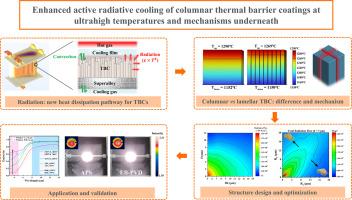超高温下柱状热障涂层的增强辐射冷却及其机理
IF 14.3
1区 材料科学
Q1 MATERIALS SCIENCE, MULTIDISCIPLINARY
引用次数: 0
摘要
航空发动机涡轮入口温度的持续上升,加大了对热障涂层隔热性能的要求。传统上,降低热传导系数一直是提高热传导系数的主要策略。柱状tbc通常被认为比层状tbc具有更高的导热性和较差的绝热性。然而,在这项研究中,我们证明了在超高温条件下(>1300°C),柱状tbc由于在近红外区域具有较高的发射率而表现出优越的辐射冷却能力。这种增强的辐射散热有效地抵消了其高导热性的局限性。提出了一种新的“黑体效应”假说来解释这种行为。有限元模拟定量地证实了这一假设,显示出与实验观察的强烈一致。这些发现提供了一个突破性的观点:尽管柱状涂层的导热性更高,但通过增强辐射冷却能力,可以在超高温下缩小与层状涂层的隔热差距。这项工作为优化发射率提供了一种新的结构策略,拓宽了下一代tbc的设计框架。本文章由计算机程序翻译,如有差异,请以英文原文为准。

Enhanced radiative cooling of columnar thermal barrier coatings at ultrahigh temperatures and mechanisms underneath
The continuous rise in turbine inlet temperatures in aero-engines has intensified the need for improved thermal insulation in thermal barrier coatings (TBCs). Traditionally, reducing the thermal conductivity of TBCs has been the primary strategy to enhance their thermal insulation. Columnar TBCs are generally deemed to have higher thermal conductivity and inferior thermal insulation compared to lamellar TBCs. However, in this study, we demonstrate that under ultra-high temperature conditions (>1300°C), columnar TBCs exhibit superior radiative cooling capabilities due to their higher emissivity in the near-infrared region. This enhanced radiative heat dissipation effectively offsets the limitations of their high thermal conductivity. A novel "blackbody effect" hypothesis is proposed to elucidate this behavior. Finite element simulations quantitatively substantiate this hypothesis, showing strong agreement with experimental observations. These findings offer a groundbreaking perspective: columnar coatings, despite higher thermal conductivity, can narrow the thermal insulation gap with lamellar coatings at ultra-high temperatures through enhanced radiation cooling capabilities. This work provides a new structural strategy for optimizing emissivity and broadens the design framework for next-generation TBCs.
求助全文
通过发布文献求助,成功后即可免费获取论文全文。
去求助
来源期刊

Journal of Materials Science & Technology
工程技术-材料科学:综合
CiteScore
20.00
自引率
11.00%
发文量
995
审稿时长
13 days
期刊介绍:
Journal of Materials Science & Technology strives to promote global collaboration in the field of materials science and technology. It primarily publishes original research papers, invited review articles, letters, research notes, and summaries of scientific achievements. The journal covers a wide range of materials science and technology topics, including metallic materials, inorganic nonmetallic materials, and composite materials.
 求助内容:
求助内容: 应助结果提醒方式:
应助结果提醒方式:


